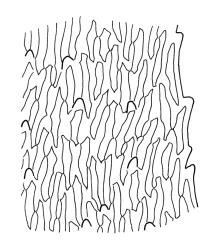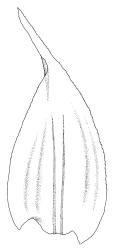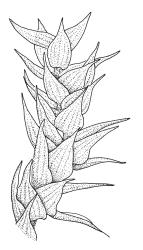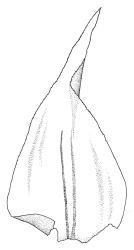- ≡ Hypnum triquetrum Hedw., Sp. Musc. Frond. 256 (1801)
Plants robust and coarse, bright-green, ± dull, forming loose and shaggy wefts. Stems c. 100 mm or more in N.Z. material, orange-brown, clearly visible between leaves, irregularly branched, ascendant; branches mostly tapered and decurved at tips. Stem and branch leaves differentiated. Stems leaves not sheathing, wide-spreading, broadly ovate-lanceolate, auriculate and clasping at base, scarcely concave, distinctly plicate moist or dry, ± rugose when dry, gradually tapered to a non-channelled and nearly flat acumen, cordate and clasping at base, serrulate to base or nearly so, c. 4.0–4.8 × c. 2 mm; mid laminal cells oblong-linear, strongly prorate-spinose (upper cell ends projecting on abaxial surface, most conspicuously at plications), distinctly porose, mostly c. 40–50 × 6–7 µm, becoming longer but otherwise differing little towards leaf base; alar cells scarcely differentiated, porose. Branch leaves narrower and more lanceolate. Costae c. ⅔ the leaf length. Pseudoparaphyllia not seen.
Perigonia gemmiform, yellow, scattered on main stems. Perichaetia and sporophytes not known from N.Z.
Crum & Anderson 1981, figs 604–605; Noguchi 1987–1994, fig. 522; Smith 2004, fig. 311, 5–7.
SI: Nelson (St Arnaud).
Adventive. Adventive also in Tasmania. Widespread in the northern hemisphere.
Known from several well-documented collections from one restricted locality at St Arnaud (c. 640 m elevation) in Nelson Lakes N.P. There it grows on duff beneath 4–6 m high scrub of manuka (Leptospermum scoparium), forming nearly pure wefts of up to one square metre that are invading adjacent mats of Acrocladium chlamydophyllum, Ptychomnion aciculare, and Thuidium furfurosum. Its pattern of growth at St Arnaud suggests that it might be capable of invading undisturbed scrub and montane forest and its presence is therefore a source of particular management concern. Work by the Department of Conservation to eradicate it at St Arnaud is on-going. Considerable success has been achieved by raking and burning the larger colonies and by subsequent application of iron sulphate solutions to remaining plants, but further survey work is required to determine whether complete eradication has been achieved (S. Wotherspoon, pers. comm., 27 May 2014). Rhytidiadelphus triquetrus has not been found at any other N.Z. locality.
This is a dioicous species and only male plants have been found in N.Z.
This species is an abundant and widespread forest floor moss in boreal parts of North America and Europe. This coarse moss is sometimes given the apt common name "shaggy moss" in North America. Its rough and shaggy appearance makes it very distinct from any indigenous N.Z. forest species. The initial collection and recognition of this species at St Arnaud was by Jean Espie and Jim Crawford in 1997. It very likely arrived there on camping equipment brought from overseas.








